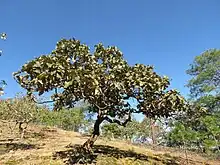Quercus jonesii
Quercus jonesii is a species of oak tree native to Mexico.[2] It is commonly known as palo manzano. It is placed in Quercus section Lobatae.[3]
| Quercus jonesii | |
|---|---|
 | |
| Scientific classification | |
| Kingdom: | Plantae |
| Clade: | Tracheophytes |
| Clade: | Angiosperms |
| Clade: | Eudicots |
| Clade: | Rosids |
| Order: | Fagales |
| Family: | Fagaceae |
| Genus: | Quercus |
| Subgenus: | Quercus subg. Quercus |
| Section: | Quercus sect. Lobatae |
| Species: | Q. jonesii |
| Binomial name | |
| Quercus jonesii Trel. | |
| Synonyms[2] | |
| |
Description
Quercus jonesii is small tree which typically reaches 4–8 metres (13–26 feet) in height.[1]
Distribution and habitat
The species is native to the Sierra Madre Occidental, Sierra Madre Oriental, and smaller ranges of the Mexican Plateau in between the two Sierras, in the states of Aguascalientes, Chihuahua, Durango, Guanajuato, northern Jalisco, eastern Nayarit, San Luis Potosí, Nuevo León, Sinaloa, and Sonora[1]
It is found in pine–oak forests, oak forests, and oak and pine–oak woodlands. It typically grows in isolated patches on well-drained rocky slopes in otherwise humid areas. It is often associated with Q. eduardi, Q. resinosa, and Q. laeta.[1]
References
- Jerome, D. (2018). "Quercus jonesii". IUCN Red List of Threatened Species. 2018: e.T89238868A89238882. doi:10.2305/IUCN.UK.2018-1.RLTS.T89238868A89238882.en. Retrieved 18 November 2021.
- "Quercus jonesii Trel." Plants of the World Online. Royal Botanic Gardens, Kew. Retrieved 2023-02-28.
- Denk, Thomas; Grimm, Guido W.; Manos, Paul S.; Deng, Min & Hipp, Andrew L. (2017). "Appendix 2.1: An updated infrageneric classification of the oaks" (xls). figshare. Retrieved 2023-02-24.
